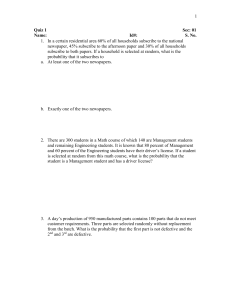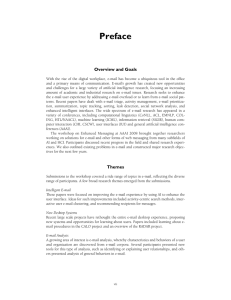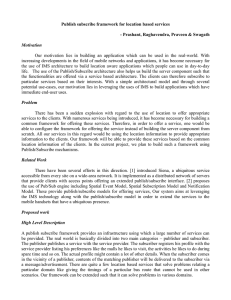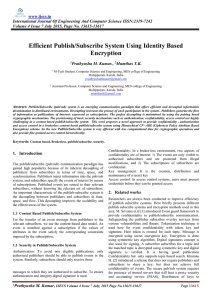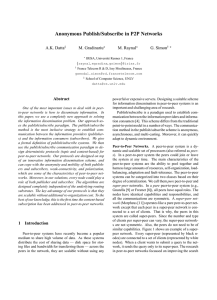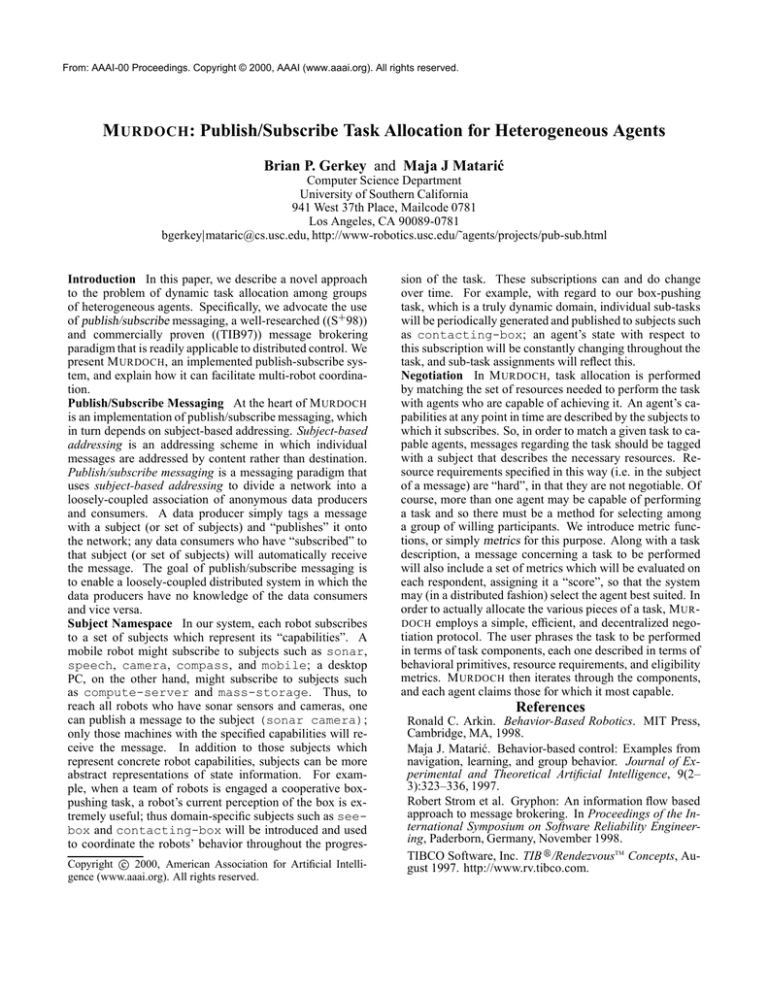
From: AAAI-00 Proceedings. Copyright © 2000, AAAI (www.aaai.org). All rights reserved.
M URDOCH: Publish/Subscribe Task Allocation for Heterogeneous Agents
Brian P. Gerkey and Maja J Matarić
Computer Science Department
University of Southern California
941 West 37th Place, Mailcode 0781
Los Angeles, CA 90089-0781
bgerkeyjmataric@cs.usc.edu, http://www-robotics.usc.edu/˜agents/projects/pub-sub.html
Introduction In this paper, we describe a novel approach
to the problem of dynamic task allocation among groups
of heterogeneous agents. Specifically, we advocate the use
of publish/subscribe messaging, a well-researched ((S+ 98))
and commercially proven ((TIB97)) message brokering
paradigm that is readily applicable to distributed control. We
present M URDOCH, an implemented publish-subscribe system, and explain how it can facilitate multi-robot coordination.
Publish/Subscribe Messaging At the heart of M URDOCH
is an implementation of publish/subscribe messaging, which
in turn depends on subject-based addressing. Subject-based
addressing is an addressing scheme in which individual
messages are addressed by content rather than destination.
Publish/subscribe messaging is a messaging paradigm that
uses subject-based addressing to divide a network into a
loosely-coupled association of anonymous data producers
and consumers. A data producer simply tags a message
with a subject (or set of subjects) and “publishes” it onto
the network; any data consumers who have “subscribed” to
that subject (or set of subjects) will automatically receive
the message. The goal of publish/subscribe messaging is
to enable a loosely-coupled distributed system in which the
data producers have no knowledge of the data consumers
and vice versa.
Subject Namespace In our system, each robot subscribes
to a set of subjects which represent its “capabilities”. A
mobile robot might subscribe to subjects such as sonar,
speech, camera, compass, and mobile; a desktop
PC, on the other hand, might subscribe to subjects such
as compute-server and mass-storage. Thus, to
reach all robots who have sonar sensors and cameras, one
can publish a message to the subject (sonar camera);
only those machines with the specified capabilities will receive the message. In addition to those subjects which
represent concrete robot capabilities, subjects can be more
abstract representations of state information. For example, when a team of robots is engaged a cooperative boxpushing task, a robot’s current perception of the box is extremely useful; thus domain-specific subjects such as seebox and contacting-box will be introduced and used
to coordinate the robots’ behavior throughout the progres-
Copyright c 2000, American Association for Artificial Intelligence (www.aaai.org). All rights reserved.
sion of the task. These subscriptions can and do change
over time. For example, with regard to our box-pushing
task, which is a truly dynamic domain, individual sub-tasks
will be periodically generated and published to subjects such
as contacting-box; an agent’s state with respect to
this subscription will be constantly changing throughout the
task, and sub-task assignments will reflect this.
Negotiation In M URDOCH, task allocation is performed
by matching the set of resources needed to perform the task
with agents who are capable of achieving it. An agent’s capabilities at any point in time are described by the subjects to
which it subscribes. So, in order to match a given task to capable agents, messages regarding the task should be tagged
with a subject that describes the necessary resources. Resource requirements specified in this way (i.e. in the subject
of a message) are “hard”, in that they are not negotiable. Of
course, more than one agent may be capable of performing
a task and so there must be a method for selecting among
a group of willing participants. We introduce metric functions, or simply metrics for this purpose. Along with a task
description, a message concerning a task to be performed
will also include a set of metrics which will be evaluated on
each respondent, assigning it a “score”, so that the system
may (in a distributed fashion) select the agent best suited. In
order to actually allocate the various pieces of a task, M UR DOCH employs a simple, efficient, and decentralized negotiation protocol. The user phrases the task to be performed
in terms of task components, each one described in terms of
behavioral primitives, resource requirements, and eligibility
metrics. M URDOCH then iterates through the components,
and each agent claims those for which it most capable.
References
Ronald C. Arkin. Behavior-Based Robotics. MIT Press,
Cambridge, MA, 1998.
Maja J. Matarić. Behavior-based control: Examples from
navigation, learning, and group behavior. Journal of Experimental and Theoretical Artificial Intelligence, 9(2–
3):323–336, 1997.
Robert Strom et al. Gryphon: An information flow based
approach to message brokering. In Proceedings of the International Symposium on Software Reliability Engineering, Paderborn, Germany, November 1998.
TIBCO Software, Inc. TIB r /RendezvousTM Concepts, August 1997. http://www.rv.tibco.com.

